Seamless collaboration during the entire software development lifecycle helps teams complete projects successfully and achieve higher customer satisfaction. Not only does it result in faster deployment and delivery, but it also reduces friction among team members. DevOps tools tick off all these aspects, which is why DevOps is witnessing surplus adoption in recent years.
A report published in November 2019 by DZone says that the DevOps market generated $2.9 billion in 2017, and this number is projected to reach around $6.6 billion by 2022. Despite its continuous adoption in organizations of different scales, many are confused about the real meaning of DevOps.
One of the many misconceptions about DevOps is thinking of it as just a tool, while others are confused about its approach, philosophy, culture, and aims. There is no single DevOps tool but rather a set of DevOps tools or toolchains essential for DevOps engineers, developers, operators, and others in the team.
This article introduces you to DevOps, its practices, culture, benefits, and more. Furthermore, we’ve also hand-picked the 30 best DevOps tools for various stages in the software development lifecycle.
Let’s begin!
What Is DevOps?
DevOps is the amalgamation of practices, cultural philosophies, and tools to increase the ability of an organization to deliver IT services and applications faster than traditional development processes.
By adopting DevOps, organizations can improve their products, serve the customers well with quick feedback and fixes, get a competitive edge in the market, and achieve their business objectives faster.
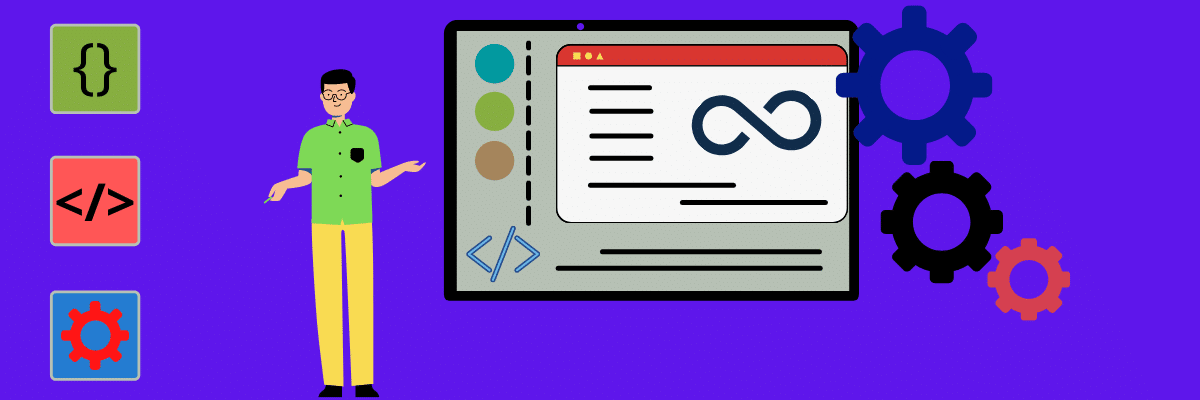
Simply put, DevOps is a mindset that helps remove roadblocks in traditional development processes and operations and shortens the software development life cycle.
This model enables development teams and operations teams to work together effectively during the entire software lifecycle, from the development phase and testing to deployment and operations.
The use of technology in DevOps implementation is also one of the critical aspects. Numerous DevOps tools leverage dynamic and programmable infrastructure and are available for automation, testing, configuration, integration, delivery, and other processes.
The Origin of DevOps
Patrick Debois coined the term “DevOps” in 2009. He is a Belgian consultant, agile practitioner, and project manager, who became one of the early DevOps leaders and formed this word by combining “Dev” as in development, and “Ops” as in operations.
Here, “Dev” doesn’t only mean developers, but everyone involved in developing a software product from disciplines like Q&A, development, testing, planning, etc.
Similarly, “Ops” is an umbrella term for everyone involved in the operations team, including system engineers, database administrators, system administrators, security experts, network engineers, release engineers, operations staff, and others.
As explained in the previous section, DevOps is a mindset or culture. And this mindset is not something that was carved out of a single rock.
Instead, it originated in the best minds years ago and was nurtured and conceptualized by forward-thinking experts from various IT disciplines.
Many fundamental DevOps ideas are inspired by practices like Lean, Agile, enterprise system management, The Toyota Way, and Deming’s Plan-Do-Check-Act method.
In 1993, the Telecommunications Information Networking Architecture Consortium defined a Model of Service Lifecycle. This model combined telecom operations with software development.
Some professionals say DevOps emerged slowly as a method opposing the “top-down” ITIL prescriptive approach. Instead, DevOps favored a “bottom-up” approach and gained traction, providing a flexible software development practice instead of a rigid framework.
In 2009, “Devopsdays,” the first-ever conference based on DevOps, was held in Belgium. Patrick Debois laid the foundation of this conference, which spread as a movement to other parts of the world.
Let’s discuss the two main antecedent methods of DevOps:
1. Enterprise Systems Management (ESM)
ESM rose in the 2000s, whose approach of running various systems was still in a primitive state. This is why efforts were initiated to evolve it. This phase saw the development of ITIL Lite and Visible Ops methodology. Additionally, more minor, open source solutions for end-to-end system management started surfacing, including Zenoss, Hyperic, Spiceworks, etc.
Amongst people involved initially in DevOps development, many were system admins who introduced the main best practices of ESM to DevOps. These practices include configuration management, automated provisioning, toolchain approach, and system monitoring.
More conferences were held in 2008 and 2009, focusing on operations and web performance and sharing best practices around these processes. Slowly, provisioning tools such as Chef and Puppet were released, and it made people think more about these new practices and how to implement them.
2. Agile Development
Parallelly, agile development was growing in the software development world. It enables close collaboration between developers, product managers, QA, and even customers to fill the gaps and accelerate delivering a better product.
The primary focuses of this movement were processes and analogies, including lean manufacturing, kanban processes, and system administrators.
Many organizations and companies have started including DevOps in their software development cycle to expedite the process and achieve faster and better results.
Why Was DevOps Created?
System administrators and developers could disagree on various grounds, but they agree that both must meet the demands of growing customers’ needs.
This demand includes the need for new features, revenue streams, services, and better products in addition to a system that’s more secure, stable, high performing, and devoid of interruptions and outages.
All these needs require the involvement of both system admins and developers to present a better service or product before the customers.
Now, the problem is companies may get overwhelmed with these frequently changing and ever-evolving customer demands. They may feel the need to choose one option between:
- Dealing with an unstable environment and delivering quick changes
- Maintaining a highly stable production environment but stale.
Unarguably, both options seem unacceptable because they won’t help an enterprise provide the best possible solutions to their customers.
It created the dire need for a system or practice that could balance both sides of the production environment, development, and operations.
And the solution to this problem is DevOps!
It was created to strike a balance on either side, so even if the developers craft a faster product, operations can find ways to stabilize the system.
DevOps is a way that can integrate all the people associated with software development to its deployment that includes business users, security engineers, developers, system admins, test engineers, QA, and others.
All of them will be integrated into a highly automated, single workflow sharing a common goal: to deliver high-quality software rapidly that can meet user demands while ensuring the stability and integrity of the system.
And this is how DevOps came into being.
Next, you may think about why you should use DevOps in the first place when you have other options around.
Don’t worry. The answer is right ahead!
What Are the Benefits of DevOps?

Teams adopting DevOps culture, tools, and practices collaborate effectively, become more productive, deliver better products faster, and achieve higher customer satisfaction to fulfill business goals.
DevOps helps enhance business agility by offering a productive environment that nurtures mutual collaboration, fruitful communication, and seamless integration across teams in an organization, no matter where the team members are present on the globe.
According to an UpGuard report, 63% of organizations implementing DevOps experienced improved software deployments and released products more frequently.
Let’s get better clarity on how DevOps can help you and benefit your team.
1. High Development Speed
DevOps model helps developers and operational teams automate everything to innovate faster, produce high-quality software with high velocity, adapt to changes quickly, and grow their business efficiently.
2. Rapid Delivery
You can increase the speed and frequency of your releases, adapt short release cycles, and reduce time to market with the help of DevOps. When you release the product and its features quickly, you can quickly perform quick bug fixes, respond to customer needs faster, and get a competitive edge in the market with improved quality products.
3. System Stability & Reliability
DevOps practices and tools ensure software quality and stability along with all the infrastructure changes introduced. Practices like CI/CD and real-time monitoring come in handy to maintain system stability. This, in turn, increases the reliability of your software in the users’ eyes.
4. Scalability
Managing and operating development processes and infrastructure at scale is better with DevOps. Automation with consistency allows you to manage changing and complex systems efficiently with lower risks.
5. Security
DevSecOps was introduced in the pipeline, so everyone in the team is responsible for maintaining security, not just your security team. It helps you track security issues, detect them, and resolve them before they could cause any harm.
Hence, you can stay compliant and better control security using configuration management methods, automated compliance policies, and granular control.
6. Higher Customer Satisfaction
Due to accelerated software delivery, you will have enough time to collect customer feedback, track the software progress at different stages, and bring about suggested changes.
Hence, when you work on the flaws and improve software functionality based on user demands, it increases their satisfaction level. They trust your products more and become loyal customers.
7. Competitive Edge in the Market
Adapting quickly to changing market demands is the key.
DevOps implementation helps you in quick software releases, rapid delivery, high-end functionalities, tighter security, and improved customer satisfaction. You get a powerful competitive edge over others doing it the traditional way.
Plus, it also helps reduce the cost involved in the entire software cycle and maximize ROI and profitability.
How Does DevOps Work?
As we highlighted, the development team and operations work together under the DevOps ecosystem during the entire software lifecycle, developing wide-ranging skills.
Sometimes, security and QA teams also integrate tightly with DevOps, and when security is the main focus, it’s known as DevSecOps.
They use practices to automate slow and manual processes. For this, they leverage technology stack and tooling to evolve and operate applications faster and with reliability.
Let’s see how DevOps works throughout the software lifecycle.
1. Planning
DevOps teams define and ideate the software they will build while finding the customer pain points and how to solve them through the product. They describe the capabilities and features of the software.
They also plan which tools to use to ensure the team knows the tasks at hand, how many are completed, whether they can meet deadlines or not, etc.
2. Development
In the development phase, the DevOps teams perform coding, reviewing, integration, and deploying into different environments. The teams are dedicated to innovating quality products rapidly while maintaining productivity and stability.
They use DevOps tools like Chef, Terraform, Ansible, Kubernetes, etc., and automate manual and repetitive tasks. They iterate the tasks in smaller increments through continuous integration.
3. Testing
Testing is done for each code to check whether it contains any bugs or errors that could reduce the effectiveness and performance of the final product. It also helps elevate the customer experience.
For this, the DevOps tools used are Selenium, Sentry, etc.
4. Deployment
Next, DevOps teams deploy the software into a production environment reliably and consistently. This phase also involves configuring and deploying the fully controlled foundational infrastructure of the environments used.
Additionally, the DevOps teams need to define a well-crafted release process and establish automated gates to move software between stages before they are available to the end-users. This way, automation helps them produce a product with greater confidence and ease.
DevOps tools for deployment are CircleCI, Bamboo, etc.
5. Operation
The operation phase includes monitoring, maintaining, logging, and troubleshooting software in production environments.
DevOps teams aim to ensure system stability, reliability, and high availability in addition to zero software downtime while strengthening governance and security.
For this, they need complete visibility into the software and the core systems in addition to rich performance measurement, actionable altering, collecting user feedback, and more.
DevOps tools used in this phase are Prometheus, Nagios, New Relic, etc.
What Is DevOps Culture?
DevOps culture plays an important role in shaping how DevOps is implemented. It comprises a set of values that people embody while working and collaborating. Committing to a DevOps culture creates a highly productive environment for everyone included in the team.
DevOps culture involves:
1. Shorter Product Release Cycle
DevOps teams need to remain agile throughout the software lifecycle to release it in a shorter time frame. By maintaining shorter production release cycles, risk management and planning become easier and faster since each process is incremental and helps reduce the impact on system stability.
It also allows you to react quickly and adapt to changing customer needs while being competent.
2. Visibility, Collaboration, and Alignment
Visibility is the first thing that is required in the DevOps teams. Each team must always share their priorities, concerns, processes, and development among themselves so that everyone could remain on the same page.
After they have complete visibility on the work progress, development and operation teams must work together effectively with no communication gaps for rapid delivery.
While collaborating, DevOps teams must also align with the business goals, keeping in mind the timeline, quality, and ethics.
3. Accountability
When teams align, each member is accountable for their work, project completion, and successful delivery. Developers are accountable for quality and innovation during the development phase, and for the stability and performance their codes can bring about during the operation phase.
Similarly, IT operators must include security, compliance, and governance in the software during the development phase while maintaining high monitoring standards, quality checks, performance measurement, testing, and troubleshooting.
4. Growth Mindset
DevOps culture fosters a growth mindset among each member of the team and the team as a whole. Even if they fail, they examine the reasons behind their failure and implement the learnings, so they don’t commit the same mistakes again while improving continuously.
As a result, they accelerate towards innovation, take feedback seriously, increase customer satisfaction, and evolve based on market changes.
7 Essential DevOps Practices
While adopting a DevOps culture, you need to implement certain practices during the entire software lifecycle to bring DevOps’ real concept to life.
These practices help automate, improve, and accelerate various phases of the software lifecycle, from development to operation and deployment.
1. Agile Software Development
Agile is one of the software development approaches that focuses on team collaboration, higher adaptability to changing demands, user feedback, and shorter release cycles.
It’s different from other traditional frameworks like Waterfall that involve longer release cycles with sequential phases.
Agile incorporates two widely famous frameworks, Scrum and Kanban.
2. Continuous Integration (CI) & Continuous Delivery (CD)
Continuous integration is a software development practice where developers merge or integrate code changes into the primary code branch frequently. It includes automated testing that runs each time a new code is introduced to keep the primary code branch stable.
Next, continuous delivery involves automated deployment of software versions into the chosen production environment. DevOps teams can enable updates more frequently using automated deployment and reduce the number of issues occurring on deployment.
These two practices are together called continuous integration and continuous delivery (CI/CD). It includes complete automation of all the processes from coding to deployment and allows teams to remove operational overheads, human errors, and repetitive steps.
Hence, DevOps teams can emphasize building codes and deploying them quickly with lesser risks. Additionally, you can deploy more rapidly in small increments, become agile, and more confident and productive in running your codes.
3. Infrastructure as Code (IaC)
IaC defines system topologies and resources to allow your team to manage the resources during the coding phase reliably in a controlled manner. You can store and version those definitions in a version control system, so your team can review and revert quickly. It also helps reduce human errors in complex production environments.
4. Version Control
Version control involves managing codes in multiple versions with revisions and modification history, so it becomes easy to review the codes and recover them.
It’s an essential DevOps practice like CI/CD and IaC that helps your development teams to collaborate more effectively, store codes safely, divide tasks between your team members, merge changes, handle conflicts easily, and roll back code changes if needed.
Version control can be implemented using systems like Git.
5. Configuration Management
Managing system resources, including servers, databases, and virtual machines, is configuration management. You can use different DevOps tools available for this, such as Chef, Ansible, etc.
These tools help you roll out modifications systematically, and in a controlled way, so there remains no risk of changing the system configuration. DevOps tools also track your system state in addition to preventing configuration drifts that may lead to instability.
DevOps teams usually practice configuration management with IaC so that both configuration and system definition are effortless to automate, enabling teams to operate complex production environments with scalability.
6. Continuous Monitoring
Continuous monitoring is useful to get complete visibility into the health and performance of your overall application stack in real-time, from the infrastructure to high-end software components.
Monitoring includes metadata, telemetry (event logs and data), and alerts for a set of predefined conditions. DevOps teams draw meaningful insights that can help them mitigate issues faster. They can find ways to improve software quality in the next development cycles by using the information collected.
7. Microservices
Microservices is an effective design approach or architecture to build an application in several small services. These services have separate processes, and they interact with other services via a specific interface, such as an HTTP-based API.
Microservices are designed based on business capabilities, and each of them has a single purpose. They are built using different programming languages or web frameworks, and you can deploy them separately as individual services or as a cluster of services.
Who Uses DevOps and for What Purpose?
From enterprises to early-stage start-ups, DevOps is being adopted into IT companies across the globe. Here are some of the organizations that have implemented DevOps:
- Web-native businesses such as Amazon, Facebook, Netflix, etc.
- Financial services like Barclays Bank
- Media companies like Sony Pictures
- Manufacturer of building products such as USG
- Government and semi-government organizations such as The US Patent & Trade Office
- Small and medium-scale businesses
Apart from businesses, DevOps is a great approach for individuals like:
- Developers and programmers who don’t have to go through the hassles of lengthy paperwork, approval cycles, and server provisions. This way, developers can quickly provision working environments and the right resources to be more innovative and creative.
- Operational staff who can work closely with developers and bring about greater stability of the software deployments.
- Product managers and marketing and business managers also benefit from DevOps with faster customer feedback, improved system responsiveness, reduced risks, and wastes.
- Executives don’t have to be involved in every interdepartmental issue so they can invest time in crafting business expansion goals. In addition to this, DevOps culture attracts talented developers, testers, system admins, and other professionals due to the ultra-modern software development approach involving flexibility and automation.
What Are DevOps Tools?
DevOps works in the cross-functional mode, involving various tools of various kinds and purposes, instead of just a single tool. These tools are also known as DevOps toolchains, as discussed above.
The tools help throughout the software production lifecycle, including development, management, and delivery.
The organization that uses DevOps practice coordinates these tools and fits each one of them into one or more production activities like planning, creation, verification, packaging, releasing, configuring, monitoring, and version control.
We have segmented various DevOps tools based on the production activities that they can fit into.
DevOps Automation Tools
These are some of the popular DevOps automation tools:
1. Jenkins
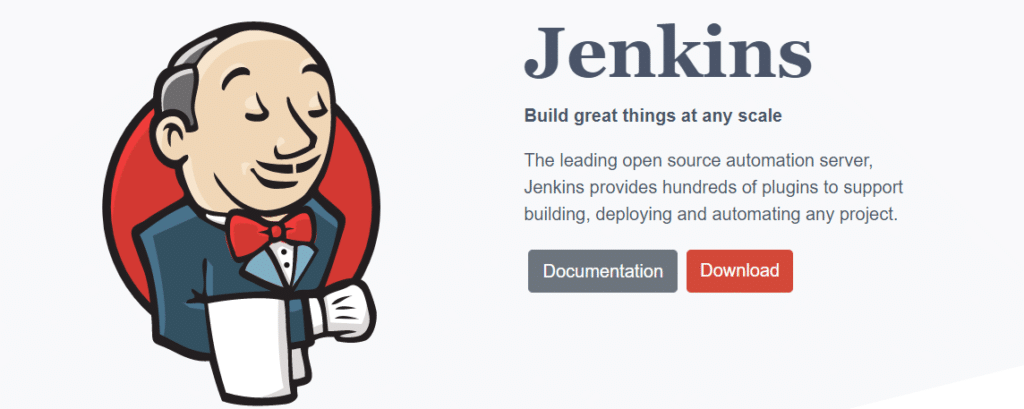
Jenkins is an open source and free automation server that helps automate software development processes such as building, facilitating CI/CD, deploying, and testing.
This DevOps tool makes it easy for teams to monitor repeated tasks, integrate changes easily, and identify issues quickly.
Features and Benefits:
- Jenkins supports 100+ plugins to integrate with almost every tool available in the CI/CD toolchain, such as Git, Amazon EC2, Maven, etc.
- It’s a self-contained program written in Java that works across major platforms, including Windows, macOS, Linux, and Unix systems.
- You can set and configure Jenkins easily using its simple web interface with built-in error checks and helps.
- Jenkins is super extensible through plugins, so you can perform a range of additional functionalities.
- Since it’s extensible, Jenkins can easily be used as a CI/CD tool for any software development project.
- As it’s a Java-based DevOps tool, you can easily distribute it across machines to accelerate builds, tests, as well as deployments.
2. Docker
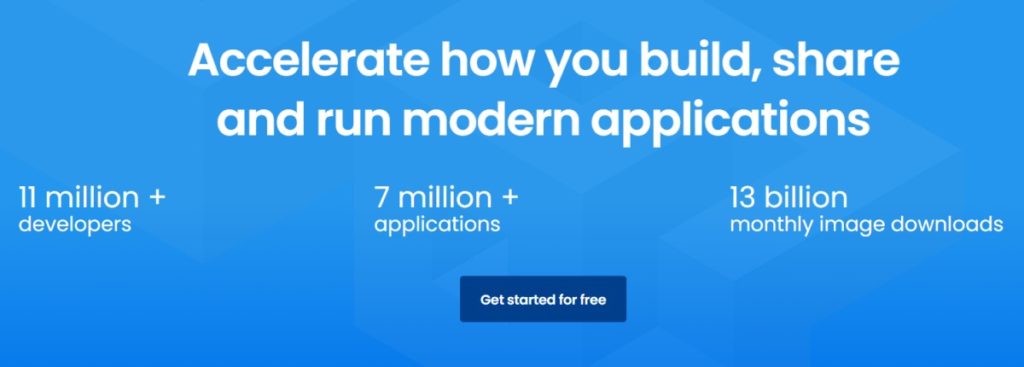
A leader in software containerization, Docker is used by 11 million+ developers across the world. Solomon Hykes is its original author and it was released in 2013 by Docker, Inc.
As a DevOps tool, Docker helps developers to build, package, and then deploy the codes with ease and speed via containers with needed dependencies instead of virtual machines. It eliminates mundane configuration activities and fosters effective team collaboration.
Docker ensures that the same software development environment is maintained across every stage of a DevOps cycle, from development to staging and production. It empowers the developers to create Docker images that they can run in the development environment and operation teams to perform testing and deployments.
Features and Benefits:
- Docker uses OS-level virtualization to deliver applications in packages referred to as a container. It’solates these containers from each other and bundles the software, configuration files, and libraries, making them transferable and more secure.
- It works easily with GCP and AWS and simplifies cloud migration
- Docker facilitates distributed development
- The tool makes it easy to add features and perform fixes
- Docker runs in Windows, macOS, and Linux
- It integrates well with deployment pipeline tools like CircleCI, GitHub, etc.
- It offers both open source and commercial solutions
- Docker is used by enterprises like Netflix, Adobe, AT&T, PayPal, etc.
3. Puppet

Developed by Puppet, Inc. and founded in 2005 by Luke Kanies, Puppet is an open source tool for software configuration management.
This DevOps automation tool helps manage different software lifecycle stages such as provisioning of IT infrastructure, patching, and configuration & management of software components and OS across cloud infrastructures and data centers.
Features and Benefits:
- It’s written in C++, Ruby, and Clojure and works with Windows, Linux, and Unix-like operating systems.
- Puppet is a model-driven tool that needs limited use of programming language.
- It uses a declarative language of its own to define system configuration
- It helps reduce manual errors and supports your team to scale with infrastructure as Code and agentless automation
- Puppet’s commercial software offers out-of-the-box reporting, node management, orchestration, product support, and access control
4. Apache Maven

Developed by the Apache Software Foundation and released in 2004, Maven is an efficient build automation tool. Written in Java, it’s used mainly for Java-based projects and acts as a project management and a comprehension tool.
As a DevOps tool, it helps manage the build, documentation, and reporting of a project. Apart from Java-based projects, you can also use Maven to develop and manage software projects written in Ruby, C#, Scala, and others.
Features and Benefits:
- Maven has predefined targets to perform well-defined tasks like code compilation and packaging.
- It downloads Maven plugins and Java libraries from its repositories to help accelerate the development process.
- It has the Apache License 2.0
- Maven comes with excellent dependency management such as automatic updating, transitive dependencies, and dependency closures.
5. Gradle

Accelerate your software development productivity using Gradle. This is also amongst open source DevOps tools for build automation, especially for multi-language application or software development.
Gradle is written in Java, Kotlin, and Groovy and was released in 2007. It’s used to automate software development, testing, and deployment at improved speeds.
Features and Benefits:
- Gradle has a rich API along with an advanced ecosystem of integrations and plugins to help with automation so that you can develop, integrate, and then systematize end-to-end software delivery.
- It has the Apache License 2.0
- Introduces a Kotlin based and Groovy-based DSL
- Uses directed acyclic graphs to prioritize tasks to run via dependency management.
- It helps you scale out your development easily with blazing-fast builds.
- Useful for developing mobile applications to microservices
- It’s versatile and can be used by start-ups and enterprises both
Other DevOps automation tools: Gulp, Graphite, CA Release Automation, Digital.ai, UrbanCode Deploy, etc.
DevOps Pipeline (CI/CD) Tools
Some of the best CI/CD DevOps tools are:
6. CircleCI

No matter your DevOps team size, this cloud-native CI/CD tool CircleCI offers reliability and speed for your software development process.
You can develop and deploy high-performing software on your infrastructure or in the cloud at scale quickly.
CircleCI was founded in 2011, and now it runs around 35M+ builds per month. It’s used by leading companies such as Spotify, PagerDuty, Ford Motor Company, Samsung, and more.
Features and Benefits:
- CircleCI runs your CI/CD pipeline automatically in a virtual machine or clean container to facilitate easy tests.
- In case of pipeline failures, it notifies your team immediately. You can also automate notifications using their Slack integration.
- Performs automated deployment of codes to a different environment to enable quick time-to-market.
- It integrates with Bitbucket and GitHub to create pipelines for your code commitments.
- It runs on Windows, macOS, Linux, and supports Docker.
- Allows you to orchestrate and define task execution for better control of the workflow.
- Supports many languages such as Javascript, C++, PHP, Python, .NET, Ruby, etc. along with innumerable frameworks, toolchains, or versions.
- Provides powerful caching options such as source codes, images, customer caches, and dependencies to speed up pipelines and achieve optimal performance.
- Lets you find and resolve issues using SSH access.
- Offers unmatched security with full VM isolation, LDAP user management, etc.
- Provides a powerful insights dashboard to track status and duration, and optimize your pipelines.
7. Bamboo

The DevOps team chose Bamboo by Atlassian for continuous integration, continuous deployment, and delivery of software applications. You can tie your automated builds, releases, and tests together as one workflow.
As s DevOps tool, it helps you create build plans in multiple stages, set up triggers, and allocate agents to critical builds as well as deployments
It’s available both as free and paid software. For developing an open source software project, Bamboo is free while charging commercial organizations based on the build agents required.
Features and Benefits:
- Supports several builds
- Includes an intuitive and user-friendly user interface
- Features tips, tools, and auto-completion
- With pre-built functionalities, the automation pipeline of Bamboo needs less configuration time than Jenkins
- Enables parallel automated tests to regress products thoroughly corresponding to each change, making bug caching faster and easier
- Integrates with many build tools and code repositories such as Git, Mercurial, JIRA, Bitbucket, Crucible, Fisheye, etc.
8. TeamCity

Released in 2006, TeamCity by JetBrains is a robust continuous integration tool for DevOps teams. It’s a general-purpose CI/CD DevOps tool that offers greater flexibility for different types of development and workflow practices.
From developers and DevOps engineers to managers and admins; TeamCity is loved by all. You can build, deploy, and test applications, containers, and packages of different types be it multi-cloud, multi-language, or multi-platform.
It’s written in Java and is available for both free and paid plans. The free license comes with a maximum of 3 build agents and 100 configurations.
Features and Benefits:
- Hundreds of plugins are available for free to install with a few clicks
- Gated commits to stop developers from breaking source codes in version control systems
- Real-time reporting for faster issue resolves
- Integrated inspections, code coverage, duplicate search, etc.
- Build Grid to allow multiple tests and builds running on different environments and platforms simultaneously
- Supports Java, Ruby, and .NET platforms
- Supports Git, Subversion, Mercurial, etc. version control systems
- Integrates with IDEs like Visual Studio, Eclipse, and IntelliJ IDEA
9. Travis CI
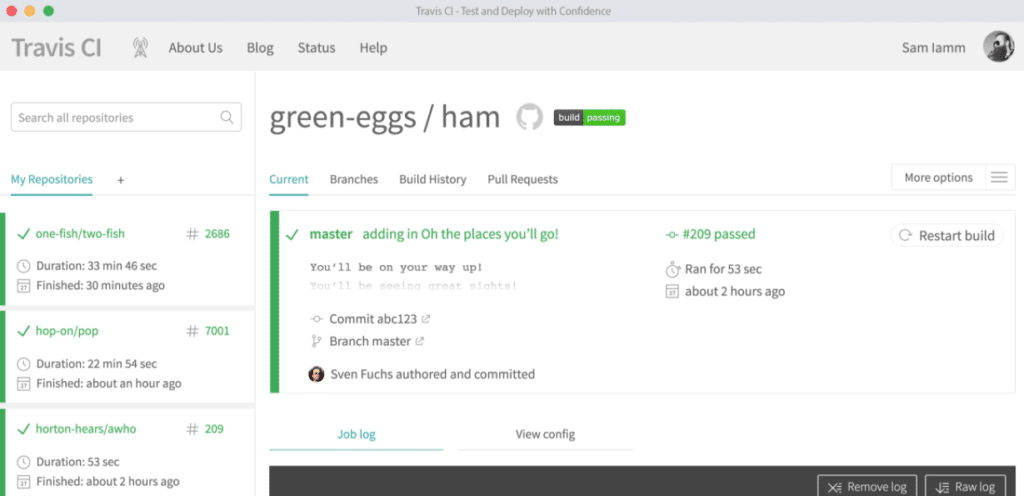
Best suited for open source projects, Travis CI is an efficient continuous integration (CI) tool to develop and test applications hosted on GitHub or Bitbucket. It was written in Ruby and has an MIT license.
This cloud-hosted service detects all the new code commits automatically and how many codes are pushed to your GitHub repository to help you build the software and test it accordingly.
Features and Benefits:
- Quick setup and compatible with Linux, Mac, and iOS
- Supports Java, Python, PHP, Perl, etc.
- It features automatic deployments
- Offers clean VMs for each build
- Comes with pre-installed databases, live-build statistics, and Parallel testing
- Offers an enterprise-level access control for superior security
- Provides an on-demand scaling capacity
10. Buddy

If you find an effective DevOps tool for CI/CD to build your software faster, Buddy can be your best ‘buddy’. This tool helps in continuous integration and deployment along with feedback.
It’s suitable for projects using codes from GitHub and Bitbucket repositories. It also allows you to use Docker containers in addition to pre-installed frameworks and languages to build the software, and also monitors and sends alerts.
Features and Benefits:
- Comes with a user-friendly and simple user interface
- Offers faster deployments with change detection, parallelism, advanced caching, 360-degree optimizations, RAM and vCPU scaling, etc.
- Allows you to perform 100+ actions such as running SSH commands, Docker images, generating static sites, orchestrating Kubernetes clusters, using RPM tools, and more apart from building and deployments
- Integrates with Selenium, MariaDB, Redis, Memcached, Firefox, Chrome, and more
- Features workflow management using templates to import and export pipelines and cloning
Other DevOps CI/CD tools: GoCD, Mercurial, Azure DevOps Pipelines, Chrome DevTools, Sublime Text, etc.
DevOps Version Control Tools
Version control DevOps tools are:
11. Git
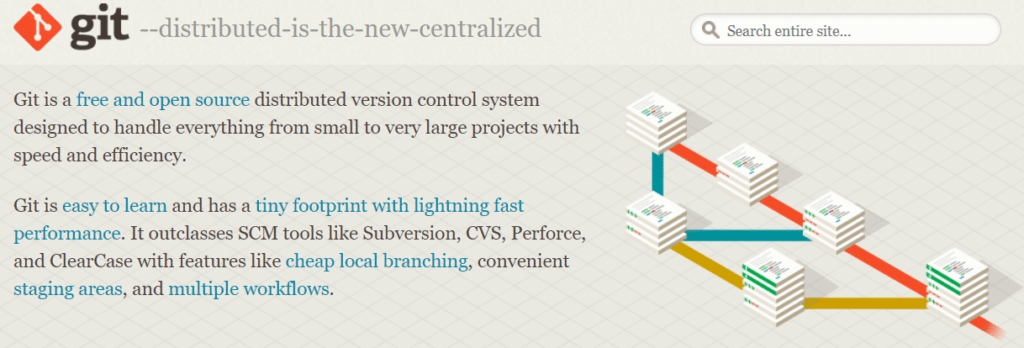
One of the most widely recognized DevOps tools, Git’s an open source and free version control software. Released in 2005, it was written in C, Perl, Shell, and Tcl, and originally authored by Linus Torvalds.
This distributed source code management (SCM) tool is used to track changes in files for software development and coordinate work effectively among programmers. It aims at increasing the speed, support, and data integrity for non-linear, distributed workflows.
Each Git directory over a computer is fully-fledged with complete version-tracking capability and history.
Features and Benefits:
- Works on Windows, macOS, Linux, Solaris, and AIX
- It has the GPL v2 license
- Can handle projects of different scales, from small to large projects while maintaining efficiency and speed
- Easy to learn and use by beginners and experts alike
- Provides a competitive edge with features like convenient staging environments, multiple workflows, commits, check-in, and multiple local branching
- To integrate it with your workflow, host repositories from GitHub or Bitbucket so your team can push tasks easily
12. GitHub

Millions of companies and developers trust GitHub to build, manage, and ship their software. This is the world’s most advanced and largest development platform. It provides web hosting for your software development as well as its version control utilizing Git.
Written in Ruby, C, Go, and ECMAScript, it was launched in 2008. Currently, it’s used by 56+ million users and 3M+ organizations in the world.
GitHub offers source code management and distributed version control features of Git apart from its functionalities. Its basic services are free, and that’s why it’s used to host open source projects mostly.
Features and Benefits:
- Demonstrates improved access controls
- Offers collaboration features like task management, bug tracking, continuous integration, feature requests, and wikis
- Comes with unlimited private and public repositories
- Enables you to share your projects using GitHub packages and npm
- Its mobile app helps you merge or review codes, browser repositories, manage notification, etc. with ease
- Available for Windows, macOS, and Linux and you can work using GitHub CLI or desktop
Other DevOps version control tools are Bitbucket, GitLab, Subversion, Mercurial, Gerrit, Kallithea, and more.
DevOps Configuration Management Tools
Look at some of the best DevOps tools for configuration management:
13. Chef
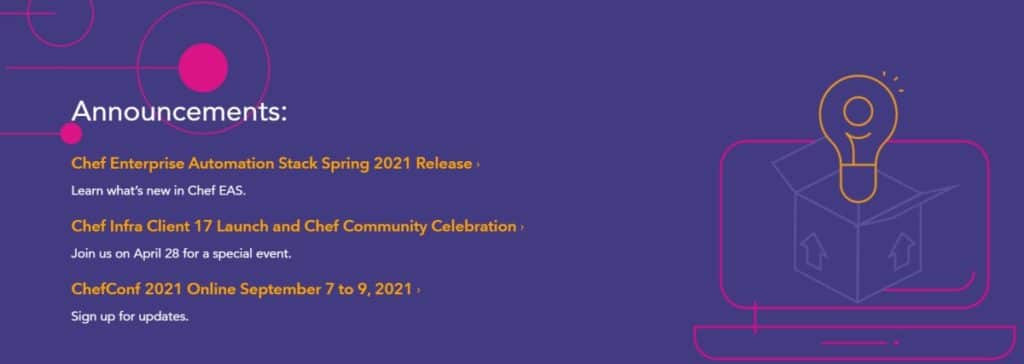
One of the oldest DevOps tools, Chef is an open source configuration management solution released in 2009.
You can use Chef to streamline the configuration and maintenance of your servers. It can also integrate with various cloud-based solutions such as Amazon EC2, Microsoft Azure, Google Cloud Platform, etc. to configure and provision new machines automatically.
It ensures that all the nodes are connected in an IT infrastructure and makes it effortless to add more nodes into it without manual updates.
Features and Benefits:
- Chef is written in Erlang and Ruby and utilizes a Domain Specific Language (DSL) that is pure Ruby for system configuration
- It helps users adapt to rapidly changing business requirements with speed, consistency, and scale
- Manages several cloud environments and data centers
- Ensures high server availability
- Chef runs in server/client mode, or as a standalone configuration tool
- It supports various platforms, including Windows, macOS, Ubuntu, Solaris, FreeBSD, RHEL/CentOS, AIX, Fedora, and Debian.
14. Kubernetes

Also referred to as K8s, Kubernetes is an open source production-grade container orchestration system to automate the deployment, management, and scaling of contained-based software.
It was written in Go and developed originally by Google, and released in 2014, but now the Cloud Native Computing Foundation takes care of its maintenance.
As one of the best DevOps automation tools, Kubernetes is useful for applications packaged with many containers. It allows developers to isolate and package container clusters logically for easy deployment to several machines.
You can employ a master-slave node arrangement to automate the container scheduling and deployment and analyze and maintain node connectivity. Using Kubernetes, you can create Docker containers automatically and assign them based on demands and scaling needs.
Features and Benefits:
- Kubernetes rolls out & rolls back changes progressively to software and/or its configuration and monitors its health
- It provides an IP address to Pods and one DNS name to a bunch of Pods in addition to load-balancing across them.
- Facilitates service traffic routing according to cluster topology
- Offers multiple storage options from local to public clouds such as AWS or GCP, or network storage solutions like NFS, Gluster, etc.
- Places containers automatically based on resources requirements without sacrificing availability
- Manages batch CI and batch workloads
- Allocates IPv6 & IPv4 addresses to services and Pods
- Offers horizontal scaling using a UI, command, or according to CPU usage
- Features Self-healing capabilities that allow restarting of containers on their failure, rescheduling and replacing them when a node dies and kills non-responding containers to health checks
15. Ansible
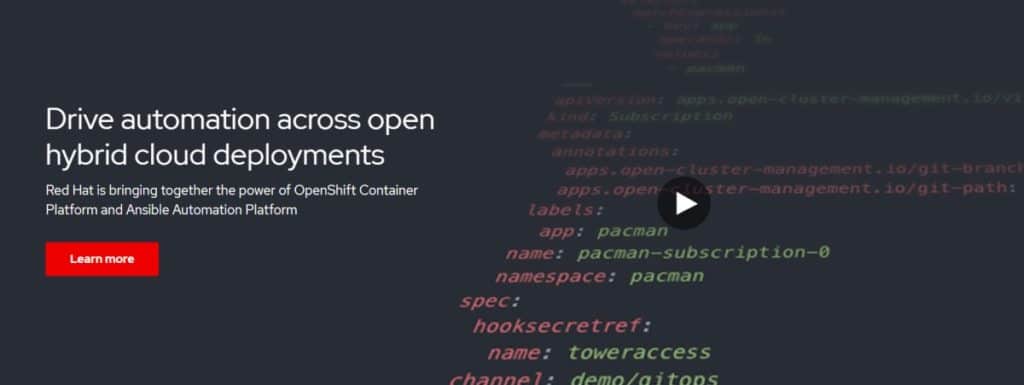
Ansible is a leading open source tool for software provision, deployment, and configuration management that enables infrastructure as code.
Written in Python, Shell, Ruby, and PowerShell, its original author is Michel DeHaan and was released in 2012. Now, Red Hat has acquired Ansible.
Being one of the renowned DevOps tools in the market, it simplifies software development automation during its entire lifecycle.
Features and Benefits:
- It works agentless and connects via SSH/remote PowerShell to complete its tasks.
- Runs on Windows, macOS, Linux, and Unix systems
- It promotes easy scalability and faster productivity
- Manages complicated deployments effortlessly
- It’s a lighter alternative to Puppet and ideal for small teams
- Integrates seamlessly with other tools like Jenkins
- Eliminates repetitive tasks with YAML templates
16. Vagrant
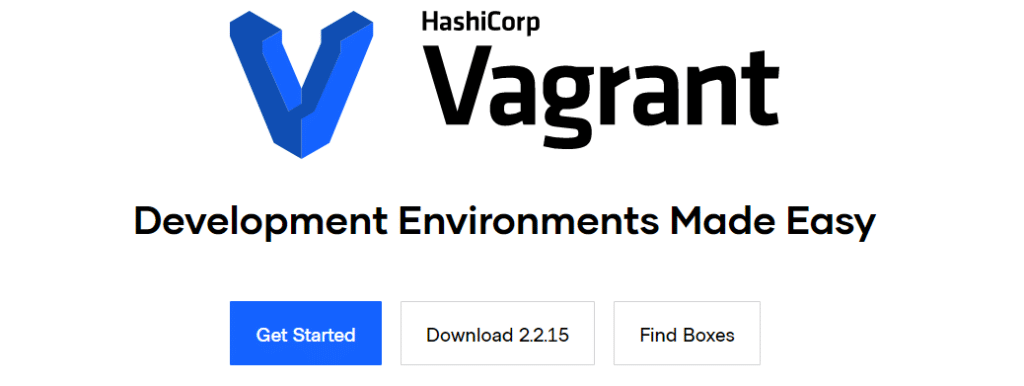
No matter your role, be it a developer, designer, or operator, in your DevOps team, Vagrant by HashiCorp offers the same, effortless workflow for everyone.
Vagrant was written in Ruby by Mitchell Hashimoto, and released in 2010. It’s an open source software to build and maintain portable, lightweight, and reproducible virtual environments like Docker Containers, AWS, VMware, etc. for software development.
In DevOps, Vagrant simplifies configuration management of software to improve development productivity.
Features and Benefits:
- Compatible with Windows, macOS, Linux, FreeBSD, Arch Linux, CentOS, and Debian
- It comes with the MIT License
- Uses declarative configuration files for software requirements, OS configuration, users, packages, and more
- Offers flexibility of choosing your preferred editor, browser, debugger, and IDE
- Integrates with other configuration management tools like Docker, Ansible, Puppet, Chef, and Salt to help you use the same configuration script as production
17. Consul
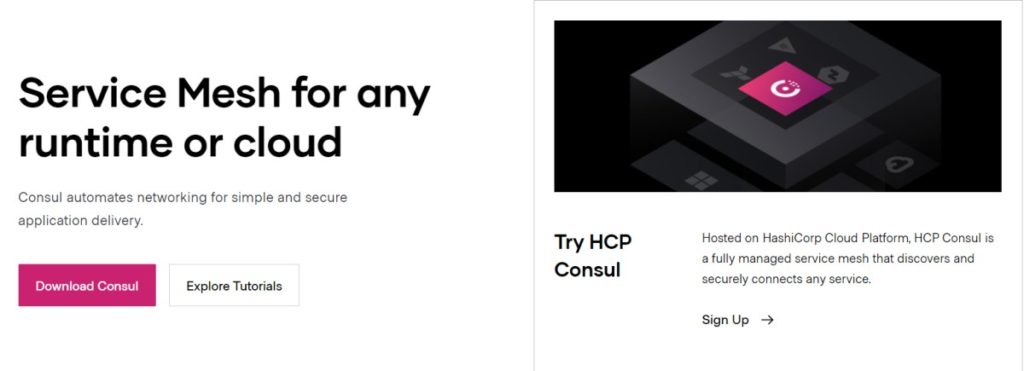
One of the best DevOps tools for configuration management is Consul by HashiCorp. It allows you to automate network configurations, use secure connections, and discover services across runtime or in the cloud. This tool is ideal for modern infrastructures.
Features and Benefits:
- You can extend its functionality by integrity Consul with Kubernetes
- Enables deployment of service mesh within an infrastructure or runtime
- Offers dynamic load balancing using 3-party tools such as Nginx, HAProxy, or F5
- Provides security to your services using mTLS encryption and intention-based policies
- Detects and deploys new services and offers real-time agent health to lower downtimes
18. Terraform
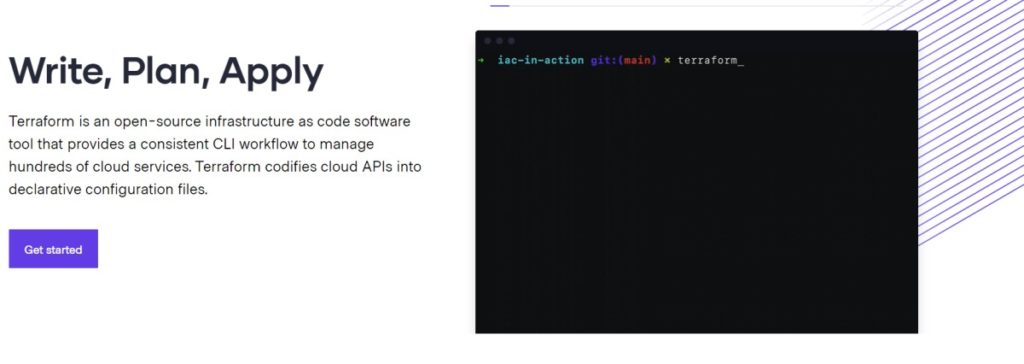
One of the notable Infrastructure as Code DevOps tools in the market is Terraform by HashiCorp. It’s an open source IaC tool that offers a consistent Command Line Interface (CLI) workflow to help you manage several cloud services.
Terraform was written in Go by Mitchell Hashimoto and was released in 2014. It incorporates HashiCorp Configuration Language (HCL), which is a declarative language to allow you to define and offer data center infrastructure. However, you can also use JSON optionally.
Features and Benefits:
- Works on Windows, macOS, Linux, FreeBSD, OpenBSD, and Solaris
- Comes with the Mozilla Public License v2
- Supports HCL language that enables concise resource descriptions using arguments, expressions, and blocks
- You can define IaC to manage software lifecycle processes such as creating new resources, destroying or managing existing ones
- Automates resource provisioning and reduces human errors
- Provisions infrastructure in over 300 services and public clouds using one workflow
Other DevOps configuration management tools are Vault, Etcd, CFEngine, SaltStack, JUJU, Cobbler, Octopus, and more.
DevOps Testing Tools
Here are some DevOps tools for testing:
19. Selenium

If you are finding a resourceful DevOps tool to automate your software testing, Selenium is a good option. You can also use it to automate boring, web administration tasks.
Selenium is an open source software released in 2018. It provides a portable framework to carry out the tests in addition to authoring functional tests with no need of learning a scripting language.
It offers a test DSL, Selenese that you can use to author tests in various programming languages such as Java, PHP, Python, C, Perl, Ruby, etc.
Features and Benefits:
- It’s compatible with most web browsers, along with OS such as Windows, macOS, and Linux.
- It has the Apache License 2.0
- Selenium is highly extensible and flexible, therefore, ideal for DevOps
- Supports parallel test execution
- Integrates with 3rd-party tools like Docker, Jenkins, Maven, and more
- It’s used by tech leaders, including Google, IBM, Salesforce, Cognizant, and others
20. Tricentis Tosca
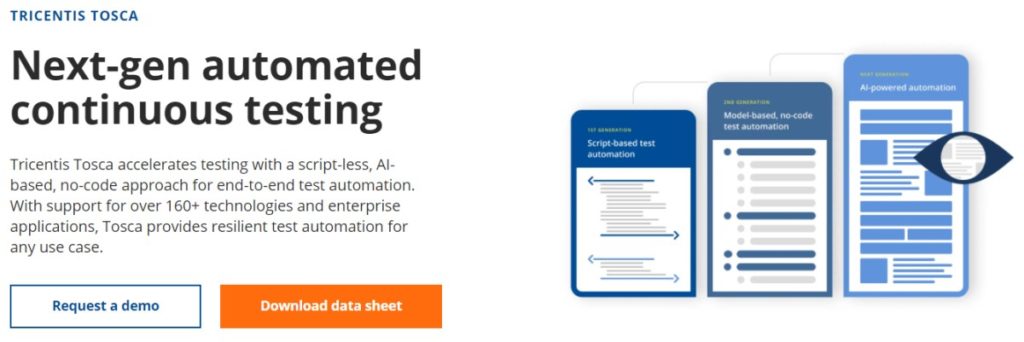
Accelerate software testing using an AI-based, scriptless tool of Tricentis Tosca that takes a no-code approach to perform end-to-end test automation. It combines different aspects of testing such as test automation, case design, data generation and design, and analytics.
Features and Benefits:
- Tricentis Tosca leverages technologies related to Risk-based testing and Model-based testing to achieve higher test automation rates with easy maintenance
- Offers many test automation capabilities to the DevOps team such as functional testing, load testing, BI/DWH testing, exploratory testing, packaged application testing, and facilitates test data management, test impact analysis, service virtualization, and distributed execution
- Supports 160+ enterprise applications and technologies Salesforce, Adobe, Oracle, SAP, Java, .NET, HTML 5, and more.
21. TestSigma
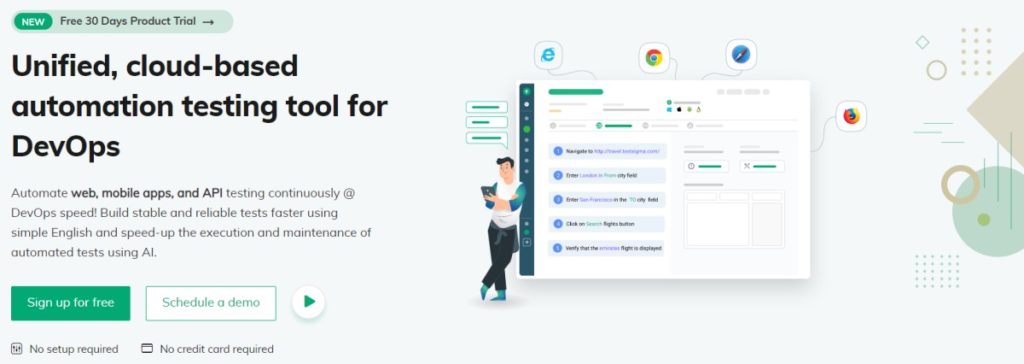
Although new in the test automation arena, TestSigma is garnering fame due to its impressive offerings. It’s a cloud-based test automation DevOps tool for web, API, and mobile apps. It leverages AI for faster test execution and maintenance.
Features and Benefits:
- Uses simple English for automated tests, hence, makes it easier for functional testers especially beginners
- Provides a unified platform for DevOps and Agile teams to involve everyone in the team
- Offers multiple types of testing such as continuous testing, mobile and web app testing, data-driven testing, cross-browser testing, and regression testing
- Allows you to extend its capabilities by writing JS and Selenium-based functions
- Enables parallel software testing to save cost and time
22. IBM Rational Functional Tester

IBM RFT offers automated functional and regression testing in addition to data-driven and GUI testing. It simplifies test editing and visualization with the natural language plus rendered screenshots.
Features and Benefits:
- RFT supports various web-based applications such as Java, .NET, SAP, and Siebel
- Supports terminal emulator-based apps such as Ajax, PowerBuilder, Adobe Flex, Adobe PDF documents, Dojo Toolkit, etc.
- Uses ScriptAssure technology to automate tests and enables test scripting
23. SoapUI

Whether you are building a commercial or open source software, SoapUI by SmartBear is an excellent option. It’s an open source software testing DevOps tool for Representational State Transfers (REST) and Simple Object Access Protocol (SOAP).
It was released in 2005 and is the only open source tool with a wide spectrum of testing capabilities such as functional, load testing, and security testing.
Features and Benefits:
- Offers an easy-to-use graphical interface
- Scriptless functional testing using drag-and-drop test creation
- Provides API mocking for your software without waiting for its completion
- Includes protocol support for REST, JMS, SOAP/WSDL
- Enables quick swapping of environments
- Provides 1-click test refactoring to update tests quickly
Other DevOps testing tools are Basis, QuerySurge, Sentry, Watir, Stackify Retrace, and more
DevOps Monitoring Tools
Next, let’s find out some DevOps tools for monitoring:
24. Nagios

When it comes to monitoring IT infrastructure, Nagios is one of the most efficient DevOps tools. It was written in C by Ethan Galstad and released in 2002.
Nagios is also an open source and free software that monitors infrastructure, systems, and networks. It offers alerting and monitoring services for applications, servers, logs, and switches. The DevOps tool aims to alert users in case of issues and notifies them when they resolve.
Features and Benefits:
- Offers cross-platform compatibility, including Linux and Unix system
- It has a GNU GPL v2 license
- Monitors network services such as HTTP, FTP, SSH, POP3, SNMP, SMTP, NNTP, and ICMP
- Also monitors host resources such as disk usage, processor load, system logs along with network OS like Windows via monitoring agents
- Monitors hardware such as probes for alarms, temperature, etc.
- Comes with a minimalist plugin design to help users develop service checks
- It’s available in Nagios XI, Core, Log Server, and Fusion.
25. Prometheus

Power your alerting and metrics using a leading open source monitoring software of Prometheus. It was written in Go and released in 2012.
It records metrics in real-time in a time-series database by using powerful queries and highly dimensional data models. Prometheus is popular among the teams leveraging Grafana.
Features and Benefits:
- Offers cross-platform compatibility
- It has the Apache License 2.0
- Identifies time series by key-value pairs and metric names
- Provides multiple modes of data visualization such as graphs, tables, etc. that makes it easy for the DevOps team to analyze data
- Features PromQL that lets you divide time series data into smaller chunks for easier generation of ad-hoc tables, graphs, and alerts
- Stores data on local disks and memory in a custom format efficiently. You can scale easily with the help of functional sharding & federation
- Offers multiple easy-to-implement client libraries for effortless service instrumentation and supports 10+ languages
- Supports data exporting from 3rd-party solutions such as JMX metrics, StatsD, HAProxy, and DevOps tools like Docker.
26. New Relic
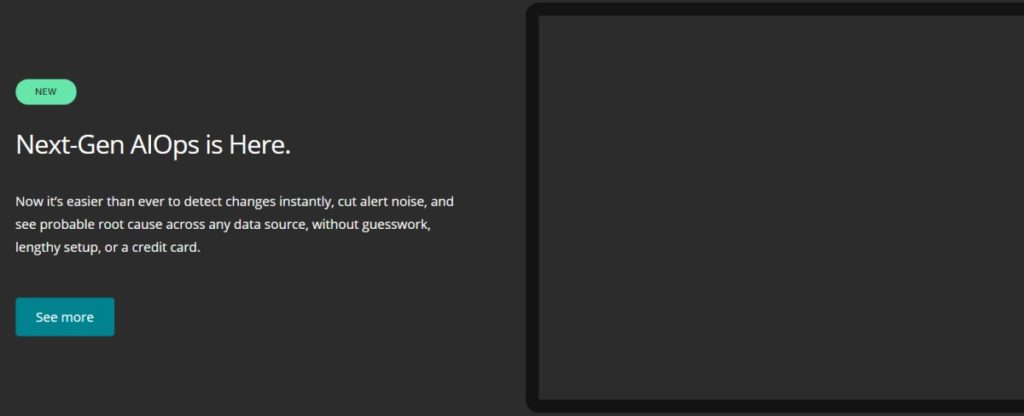
Using New Relic, you can produce better-performing software by analyzing, troubleshooting, and optimizing your overall software stack.
New Relic is a technology company founded in 2008. The platform reflects every change you make in your program with clarity.
Apart from showing the real-time status of the developmental processes, it also helps you fix issues, accelerate deploy cycles, and manage related tasks, ticking off major criteria to be a resourceful DevOps tool.
Features and Benefits:
- Enables you to gather all the telemetry data in a single place for AI-driven insights and full-stack observability, speeding up time-to-market and improve service reliance
- If you use Grafana or Prometheus environment, then also you can store data such as logs, events, traces, and metrics in New Relic
- Transitioning to a data-driven approach from reactive can help improve your customer experience
27. PagerDuty

Improve your customer experiences and protect your brand’s reputation using the real-time operations monitoring platform of PagerDuty.
As one of the most useful DevOps tools, it can help your team achieve less downtime, more productivity, and fewer outages using automation and machine learning.
Features and Benefits:
- PagerDuty is easy to use and scale
- Acting as your digital infrastructure’s nervous system, PagerDuty analyses digital signals out of software systems virtually
- With the quick incident response, you can automate tasks across teams, accelerate resolutions, and execute in-depth playbooks
- Offers alerting and task scheduling to help you take prompt actions
- Uses ML for incident context, personalized recommendations, and real-time triaging
- Supports 370+ integrations with tools such as Slack, AWS, Atlassian, Zendesk, New Relic, and more.
28. Sensu
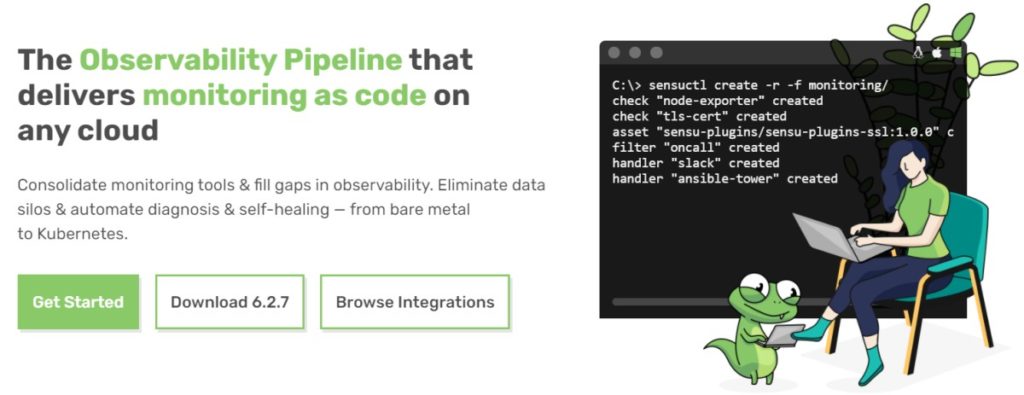
Sensu is undoubtedly one of the best DevOps tools out there for monitoring IT infrastructure. It helps you monitor servers, applications, network devices, and containers along with checking application health, measuring business KPI, and gathering and analyzing metrics.
It was written in pure Ruby and was released in 2011. It utilizes Redis for data storage and rabbitMQ for data exchanges between two components. It’s designed for use in cloud environments with server automation tools such as Ansible, Puppet, etc.
Companies using Sensu are Tesla, Yahoo, Cisco, and others.
Features and Benefits:
- It’s a cohesive tool that offers extensibility and compensability
- Sends alerts on issues and failures immediately
- Provides the option to register or deregister clients dynamically
- Works fine with multi-tiered networks and mission-critical applications
- It’s available as both free and plan license
29. Splunk

Monitor your infrastructure performance at cloud scale in real-time using Splunk’s predictive streaming analytics.
Splunk helps search, monitor, and analyze machine-generated big data using a web-like interface. It allows you to auto-discover, group, breakdown, and explore systems, services, and clouds.
Features and Benefits:
- Offers 200+ pre-built integrations with cloud services
- Features a unique dashboard to enable rapid full-stack visualization
- Lets you easily understand your infrastructure behavior across availability zones, different services, Kubernetes clusters, etc.
- By leveraging data science (such as AI and ML), it alerts accurately and instantly on dynamic thresholds, complex rules, and multiple conditions to reduce team time-to-detect and alert storms
- Helps you understand customer experiences by monitoring SLIs and SLOs with service-level insights
- Using custom business KPI metrics, you can easily track how many products are sold, their cost/workload, etc. in real-time
- Enables closed-loop automation like auto-scaling for a seamless end-user experience
30. ELK Stack
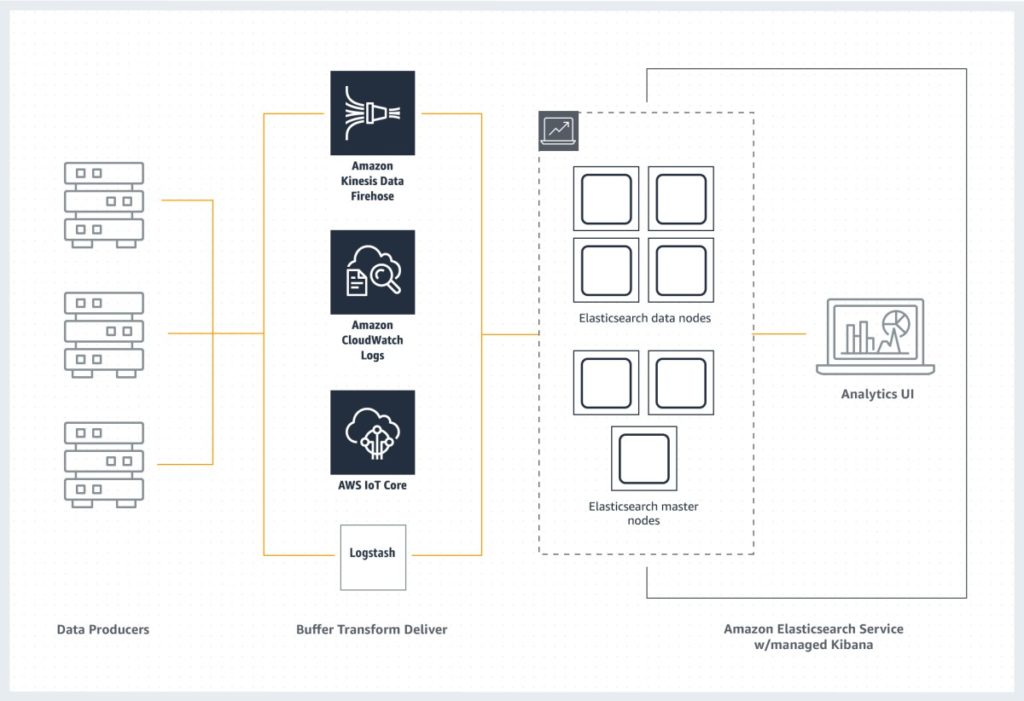
ELK Stack is a powerful combination of three open source, popular tools: Elasticsearch, Logstash, & Kibana.
ELK stack allows you to aggregate logs out of your entire applications and systems, analyze logs, create visualizations for infrastructure and application monitoring, security analytics, quick troubleshooting, and more.
- Elasticsearch is a RESTful, open source, distributed analytics and search tool built on Apache License. It supports various languages, offers high performance, includes schema-free JSON files, etc. that make this tool a great alternative for search and log analytics
- Logstash is also an open source tool for data ingestion that you can use to gather data from different sources, modify it, and send them to wherever you want. It supports 200+ plugins and pre-built filters.
- Kibana is an open source data exploration and visualization tool to review logs and events. It has effortless, pre-built, interactive filters and aggregations, and comes with geospatial support for data visualization
Other DevOps monitoring tools are Raygun, Ganglia, Snort, eG Enterprise, Datadog, and more.
Bonus DevOps Tools
Apart from the above-mentioned DevOps tools for different stages of software development, there are so many more available for collaboration, planning, continuous feedback, security, etc.
- Continuous feedback: Mouseflow, JIRA Service Desk, SurveyMonkey, SurveyGizmo, etc.
- Collaboration: Slack, Basecamp, Asana, etc.
- Planning: Atlassian Jira Align, Planview, Targetprocess, Trello, etc.
- Cloud DevOps tools: Kamaterra, OpenStack, AWS, Google Cloud Platform, Azure, IBM Cloud, etc.
Summary
We hope this article gives you an in-depth insight into the concept of DevOps, how it works, its benefits in addition to the DevOps culture and practices.
Not to mention, all the DevOps tools we have hand-picked in this article are resourceful to use across various stages of a DevOps software lifecycle, including development, CI/CD, testing, configuration management, version controls, monitoring, and so on.


